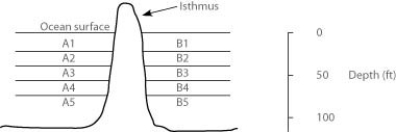In the oceans on either side of the Isthmus of Panama are 30 species of snapping shrimp; some are shallow-water species, others are adapted to deep water. There are 15 species on the Pacific side and 15 different species on the Atlantic side. The Isthmus of Panama started rising about 10 million years ago. The oceans were completely separated by the isthmus about 3 million years ago.
In the figure, the isthmus separates the Pacific Ocean on the left (side A) from the Atlantic Ocean on the right (side B) . The seawater on either side of the isthmus is separated into five depth habitats (1-5) , with 1 being the shallowest.
Which of these habitats is likely to harbor the most recently diverged species?
Definitions:
Evidence
Information or facts presented in support of an assertion, claim, or case.
Rational-Emotive Therapy
A form of psychotherapy that identifies irrational beliefs, challenging and changing these beliefs to more rational ones.
Irrational Beliefs
These are unfounded, untrue, or distorted thought patterns individuals may hold, typically leading to negative emotions or behaviors.
Internal Sentences
Thoughts or mental statements that individuals make to themselves, which can influence feelings and behaviors.
Q8: Which of the following results would be
Q9: Which of the following is not true
Q30: There is some evidence that reptiles called
Q32: Use the information to answer the following
Q51: Plants are more readily manipulated by genetic
Q52: Which of the following processes occurs during
Q54: DDT was once considered a "silver bullet"
Q59: About 450 million years ago, the terrestrial
Q60: Individuals with the disorder xeroderma pigmentosum are
Q74: Which of the following is a major